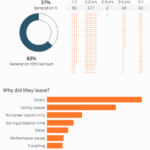Employee turnover refers to the process of employees leaving a company, and it can be defined in several ways, including:
-
Any form of departure from the company
-
Departures based on mutual agreement between employer and employee
-
Voluntary resignations—autonomous decisions made by employees to leave, often to pursue new opportunities elsewhere
The most common interpretation of employee turnover centers on voluntary exits, where employees independently choose to leave for positions at other organizations.
Key factors influencing an employee’s decision to leave include:
-
Job satisfaction – a core determinant of turnover intentions
-
Perceived job security – how stable the employee feels in their current role
-
Perceived job market opportunities – how the employee assesses their chances of finding a better position elsewhere
Additional influencing factors include:
-
Gender
-
Age
-
Marital status
-
Social influences
-
Salary and financial considerations
-
Length of service at the company
-
Professional rank or position
-
Overall economic conditions
While employee turnover results in significant costs—including recruitment, training, and lost productivity—some level of turnover can also be strategically beneficial. For example, it can help reduce overstaffing, bring in more capable talent, or naturally filter out unmotivated employees.
« Back to Glossary Index





![15 Employee Offboarding Templates That Save Hours of HR Time [Free Downloads] 15 Employee Offboarding Templates That Save Hours of HR Time [Free Downloads]](https://i1.wp.com/www.hrcloud.com/hubfs/Header.png?w=150&resize=150,100&ssl=1)
